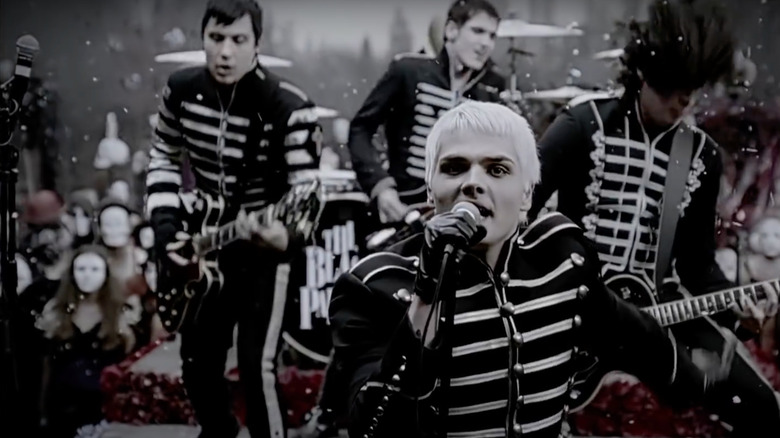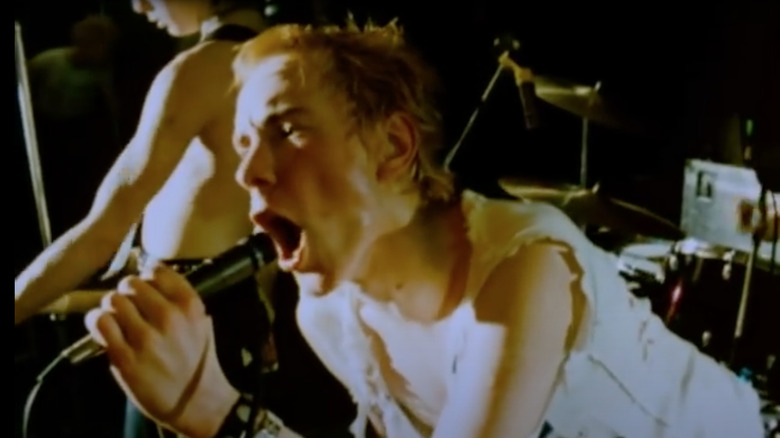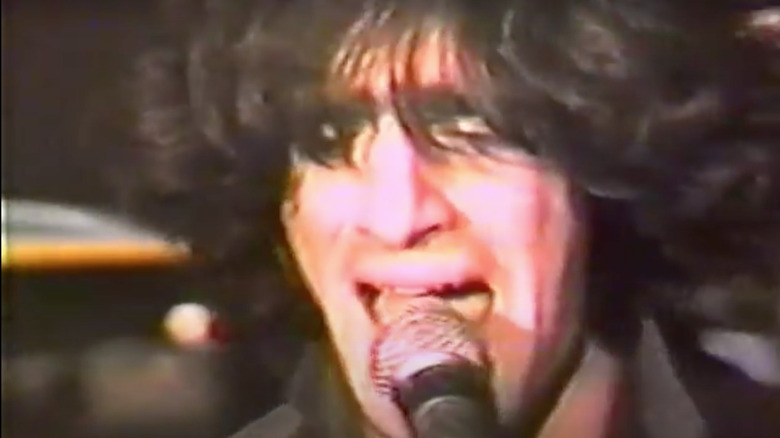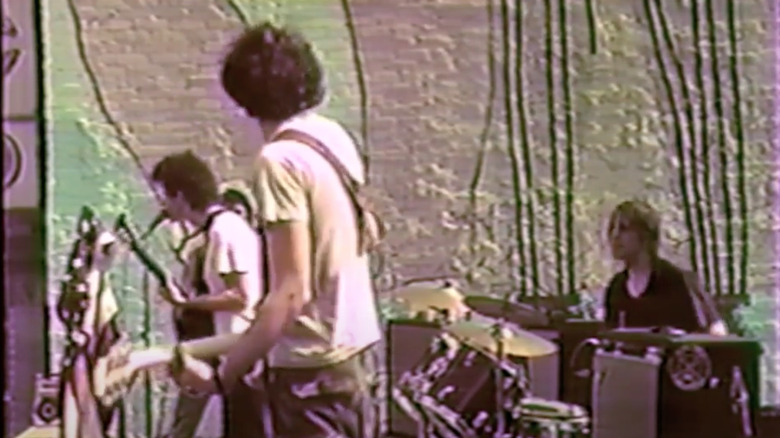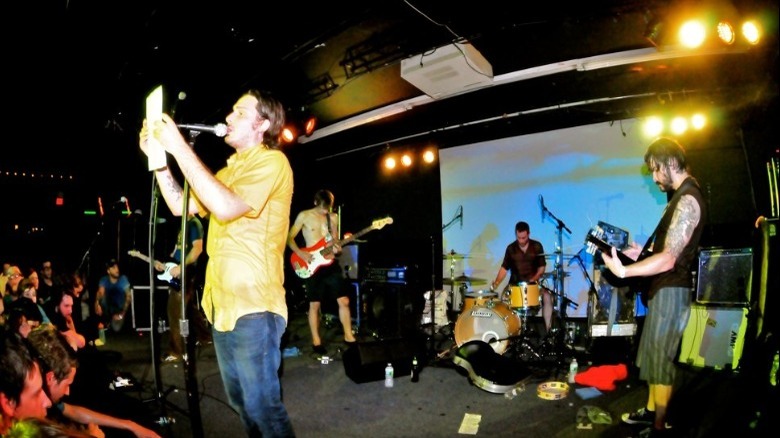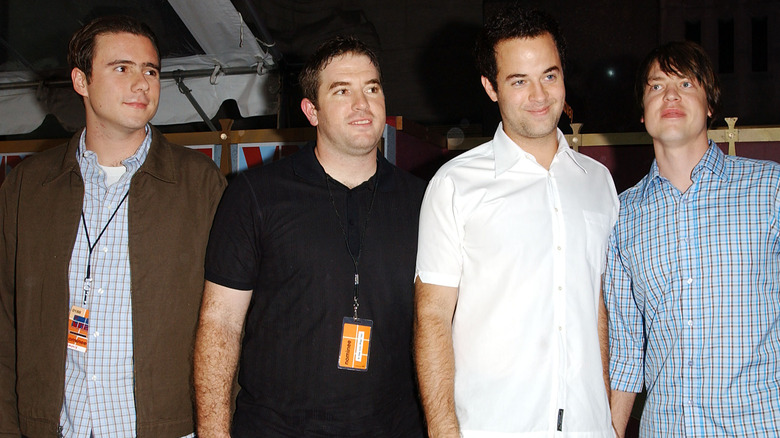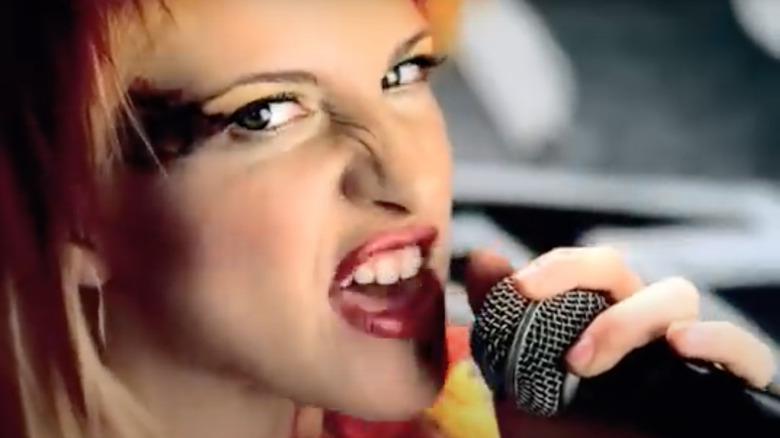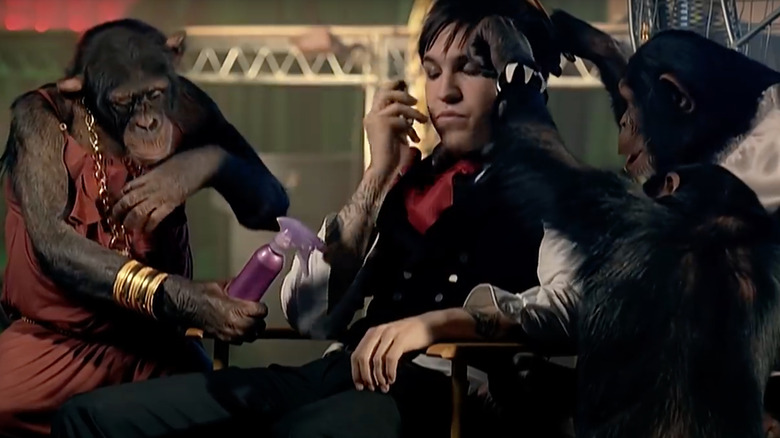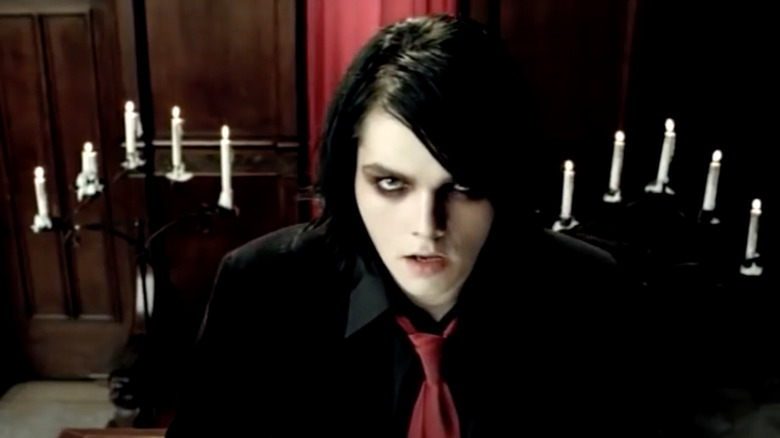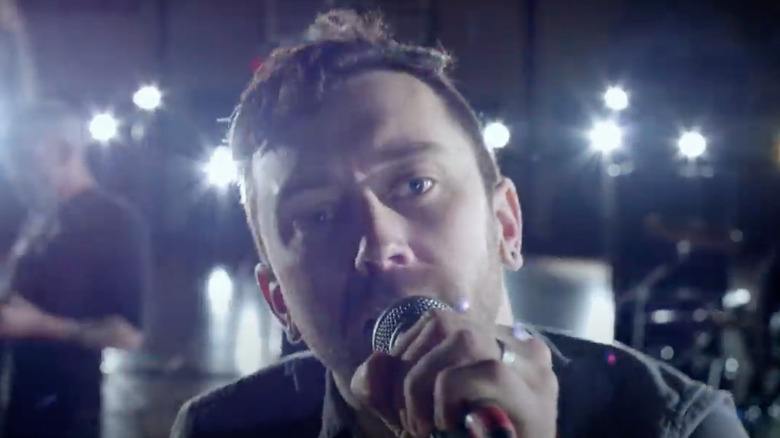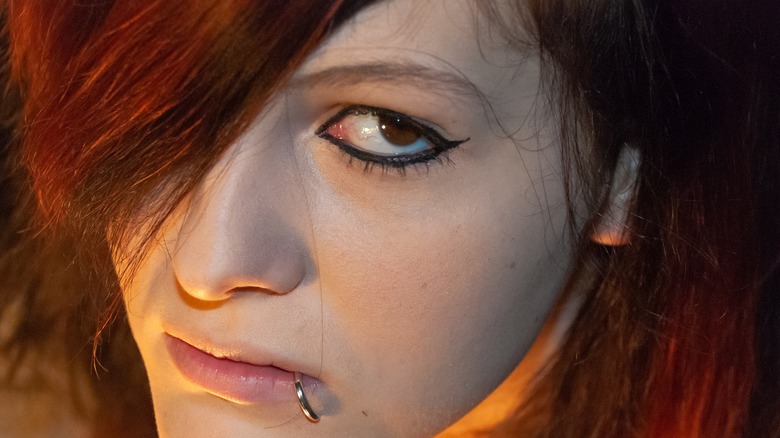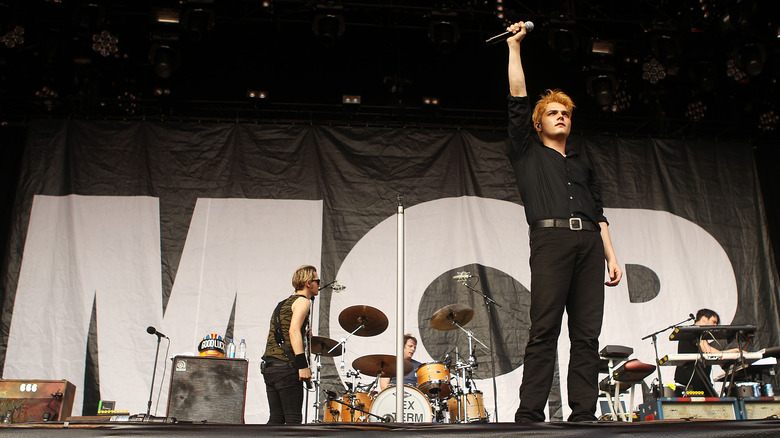The Bizarre History Of Emo Music
Time-warp back a decade or two. Were you the type who felt naked without (purposely) smudged eyeliner, wore anything that could be dyed black (including your hair), and had at least five pairs of (probably black) skinny jeans almost indistinguishable from each other? Did weekends find you listening to the next unsigned act emoting their brains out in someone's basement? Were all your friends on MySpace? Would you spend hours in your room cranking up bands that bled out lyrics like "I buried myself alive on the inside/so I could shut you out"?
If you can answer yes to any of these, especially that last one, you might have been an emo kid. Even your own peers didn't get you sometimes. You were probably no stranger to being told to plaster a smile on already, and your parents probably thought your music was a senseless outpouring of adolescent angst. Emo music was what emerged after an offshoot of hardcore experienced a metamorphosis into a brooding and unabashedly sensitive black-winged butterfly. The subculture went from underground to exploding and dying almost as fast as it reached the stratosphere, but how?
By the way, those lyrics are from The Used's song, "Buried Myself Alive," and Revolver remembers how that album, "In Love and Death," went platinum. Tell that to anyone who chronically misunderstood you.
Without punk, there would be no emo
In order to understand emo, you have to rewind to hardcore, and to get what hardcore was all about, you need to start at punk. Punk itself spawned in the underbelly of London, according to The Guardian, and manifested as a form of political backlash in the mid-to-late '70s. Bands like The Sex Pistols and The Ramones took out vengeance against the system with guitars that screamed to the heavens and lyrics that were social commentary on fire, entangling raw anger, and moral outrage.
The subculture raised more than a few eyebrows. The Sex Pistols' "God Save the Queen" skyrocketed to the top of the charts, according to the ABC News. Sid Vicious and Johnny Rotten became almost immortal. Punks and their music were often seen as incubators of violence, as CNN reports — demonized by outsiders who could not understand the social message. It was this outcry of rebellion that bred multiple genres, including hardcore.
As subgeneres of punk began to evolve during the late '70s, The State Times notes that hardcore began to distinguish itself as something more than just a louder punk doppelganger. Black Flag had turned into the poster child of hardcore by the early '80s. The raw vocals of lead singer Henry Rollins rallied socially and politically frustrated fans in Los Angeles, while the scene also surfaced in Boston, New York, and Washington, D.C.
Hardcore got emotional (and ashamed of itself)
Hardcore turned up the volume of punk even further with frantic beats and heavy lyrics blasted out with passion and fury, and soon, it gave birth to the bands that would be the progenitors of emo. Tentacles began to extend from hardcore just as they had from punk.
You could argue, as The Punk Rock MBA does, that emotion fuels all music. However, when a more emotional (depending on how you see "emotional") strain of post-hardcore started to crawl out of the hardcore scene, even some of the bands themselves did not want to be associated with what was starting to be called "emotional hardcore," or "emocore" — thank skate mag Thrasher (via Culture Creature) for that one.
Rites of Spring and Embrace were seen as "emocore," and though often credited with the inception of emo, even Rites of Spring's lead singer Guy Picciotto rejected emo as a legit musical genre. "I don't recognize that attribution," he told rock critic Mark Prindle, who has written for Spin and other publications, in 2003. "I've never recognized 'emo' as a genre of music." Piccioto went on to tell Prindle he hated the term so much because he thought it implied that other bands he played with, including hardcore band Fugazi, were void of emotion, even though feelings were spilled all over the stage.
Emocore was born from the wreckage
Early emo might sound like punk in passing. However, there were differences that gave away a mutation in the genes of punk, and no matter how Guy Piccioto insisted on his disdain for the "emocore" label, his tendency to unleash intense emotion onstage clearly said something else. Impact 89 FM says he put so much physicality into that emotion that he would exhaust himself — and held nothing back.
Unlike more classically punk bands, Rites of Spring held fast to the incensed feeling of hardcore, and while their guitar riffs weren't about to slow down, the element of hardcore that they trashed was the onslaught of violence that had started to plague that scene. "There was a situation where the [hardcore] shows were becoming increasingly, moronically violent," Fugazi's Ian McKaye told an interviewer (via The Guardian). They instead shifted the focus to their lyrics (some of them bordering on existential), which resulted in more melodic sound than the machismo of hardcore. You could say it was even vulnerable.
Other bands soon wanted in on this. In 1985, punk and early emo bands led by Rites of Spring led a musical protest known as Revolution Summer, which The Washington Post remembers as having a massive impact. It not only made punk blaze brightly but ignited what would become emo and post-hardcore.
Emo became a thing in the Midwest
Post-Revolution Summer, hardcore that morphed into emo gave rise to the bands of the second wave. Some of these bands identified by Impact 89 FM were The Get Up Kids, Jimmy Eat World, and Cap'n Jazz, who took their hardcore past and amplified the emotion. An underground scene flourished in the Midwest. The aforementioned bands, along with American Football, Sunny Day Real Estate, and others continued shaping the emo scene starting in Illinois around 1989. Unpublished Zine gives Cap'n Jazz the credit for that. Yearning vocals and slower melodies replaced some of the heavier aspects of hardcore and early emocore.
It went beyond the music. As the Central Times News observed, Midwest emo bands took on an image of '90s suburbia, with a stereotypically nerdy aesthetic (think sweater vests and dark-rimmed glasses), suburban scenes on album covers, and band names that flirted with sports from the sidelines. It was basically Michael Cera with more hair in his face.
On the heels of Cap 'n Jazz, American Football really scored here, according to WECB FM, channelling teen angst with songs like "Honestly?" It starts out tentative, almost in anticipation of something, but later bursts into an outpouring of hope and anxiety.
Or was it the East Coast?
Because the genesis of those early post-hardcore bands — the common ancestors of all emo subgenres — was in Washington, D.C., The New York Times recognizes that emo is often associated with the East Coast. Never mind that many bands that would later blow up were all from New Jersey. Among them were My Chemical Romance, Thursday, Armor For Sleep, Saves the Day, Senses Fail, Hidden in Plain View, and The Early November, but the Jersey scene didn't explode right away. There was something about New Jersey. As Drive-Thru Records owner Richard Reins told The Times in 2005, "We came back, because as label owners we couldn't be away from it."
In her book, "From the Basement," former scene kid Taylor Markarian observes that, much like their Midwestern brethren, the Jersey and other East Coast bands started out playing in garages, VFW halls, firehouses, random dives, anything to get themselves out there. Record labels eventually started to pick up local acts that rocked someone's basement.
Jimmy Eat World (who actually came from Arizona) lit up the Jersey scene when they played the Wayne Firehouse, as the New York Times also remembers. At least this was back in 2000 during their actual emo phase. Not long after the new millennium, even MTV admits they almost entirely ditched that sound for something that was pushing pop.
Emo used to be an insult
The dawn of the third wave of emo hit around the early 2000s, according to Pitchfork. The fanbase was growing exponentially. You would think being part of a subculture that was finally beginning to break into the mainstream was ultracool, but emo kids were faced with backlash. Legions of black-clad teens and 20-somethings in skinny jeans and Converse, with smeared eyeliner and bangs hanging down half their faces, became easy targets to throw stereotypes at, as Vice remembers the scene coming into its own thanks to technology. But why?
Unafraid to show intense emotion, emo was derided as being a genre for those who had no spine. The unofficial scene uniform didn't exactly help. Emo then went from being the victim to getting hit with accusations of sexism. Music journalist and critic Jessica Hopper infamously wrote a scathing opinion piece for Punk Planet (via The Guardian), called "Emo: Where the Girls Aren't," insisting that the genre was mysogynistic.
If emo really was just a whine-fest for fragile male egos that had been shattered, how do you explain Paramore's revenge anthem "Misery Business," which turns the whole thing around into a scenario starring a female throwing words like knives at her boyfriend's ex after she snatched her man back? Alt Press reveals the song was about lead singer Hayley Williams' having a crush on bandmate Josh Farro (who already had a girlfriend) back in high school.
But it still became a phenomenon
Emo built up kind of like human emotions — something you hold in until it absolutely explodes. This is what happened in the early 2000s when the relatable longing and angst of bands like My Chemical Romance, Fall Out Boy, Panic! At the Disco, and Paramore created a subculture that Impact 89 FM remembers as almost cultlike. They were the icons of what became known as, according to NME, "mall emo," which were often seen as a teenage obsession, something that all those hormonal kids hanging around the Hot Topic would eventually outgrow.
Even if some bands seemed to have sold out, there was no denying that emo had made its way from random basements to top 10 lists. Emo bands also made it onto MTV (which NME is sure to note) despite the heavy rotation of reality shows.
Just like punk and hardcore, emo was not without its subgeneres. Screamo spawned with bands like Thursday and Silverstein sadly singing melodic verses one moment and tearing their lungs out the next. Just listen to Thursday's "War all the Time."
MySpace made emo an online subculture
MySpace went online in 2003, as per Britannica, with the tagline "a place for friends." Vice recognizes that it had become the virtual hangout for scene kids that finally made them feel seen. The women Nylon Magazine calls "Scene queens," like Audrey Kitching and Jac Vanek, inspired millions of teen girls with razored bangs that fell past their black-rimmed eyes. They were the original influencers before Instagram ever existed. Warped Tour was basically Coachella for emo kids, and where the scene queens (and kings) were at. Everyone was seeking out new songs they could cry to while showing off grainy, not-yet-smartphone-quality selfies in band tees and studded belts.
Many emo bands were able to gain more of a following through the internet and whatever progenitors of social media existed back then. Music was undeniably one of the main reasons that MySpace thrived, and new bands were able to use the social networking site as a platform to advertise themselves. The more friends you could accumulate, the higher your chances of a breakthrough. Some ended up signing record deals just from going viral, according to ABC News. Bands also got exposure through PureVolume, which offered free downloads that were actually legal.
My Chemical Romance exists because of an existential crisis
Though Gerard Way denied his band's music belonged to the genre in an interview with Rolling Stone, My Chemical Romance still became the poster children for emo. Way, who grew up in New Jersey, used to be an intern for Cartoon Network in New York City, as per Vice. He was adulting as he thought he was expected to until the morning of September 11, 2001, when he watched the Twin Towers come crashing down.
That day was when, according to Kerrang, the MCR frontman had an existential crisis, quit his day job, and formed My Chemical Romance. It is no coincidence that one of the band's first songs was "Skylines and Turnstiles," which is haunted by imagery from a city in despair. Some of that mental imagery marches down a desolate street in the music video for "Welcome to the Black Parade." Speaking at a panel at Los Angeles Comic Con in 2019, Way admitted to Rocksound that "[The band] became my therapy from the PTSD that everyone had experienced from 9/11, and processing that."
Emo lyrics are often heavy for a reason (which again proves that not every song is about a jilted ex pleading for love or vengeance). This is far from the only example of unnerving, sometimes disturbing references made in the genre.
The lyrics weren't just edgy for the sake of being edgy
Call them edgelords, but emo bands had some tragic reasons for some often misinterpreted lyrics that had nothing to do with being rejected by a high school crush. The musical embodiment of the traumas they went through or atrocities that they felt the need to speak out on would make even waterproof eyeliner run.
According to MTV, Hawthorne Heights wrote "Fragile Future" (song and album of the same name) when bandmate Casey Calvert died of an accidental drug overdose after unknowingly taking the wrong medications together. Kerrang reveals that My Chemical Romance's "Helena" is Gerard Way's wrenching tribute to the grandmother who passed before he had a last chance to see her. The music video only masquerades as the ghost of an estranged lover, but knowing this isn't just a morbid metaphor for a broken heart — you will be haunted by echoes of "so long and goodnight" in the back of your head.
Not everything depressing behind emo lyrics was necessarily personal. Also according to MTV, Rise Against's "Make it Stop (September's Children)" memorialized several teen suicides that could have also been prevented had it not been for bullying set off by anti-LGBTQ+ prejudice. Rocksound notes how Alkaline Trio's "Prevent this Tragedy" is about the actual arrests and sentencing of three teens who were convicted of murder.
It burned out for a while
There are some, like Vice, who argue that emo was the last true subculture. You knew it was happening when bands like MCR and Fall Out Boy strayed from the cries of desolation that made them famous, instead experimenting with more mainstream pop sounds. The emo look was normalized until it ventured far beyond Hot Topic and even into teen magazines like Seventeen. Fast fashion meccas like H&M and Topshop rebranded at least some of their clothes and accessories to appeal to the scene crowd, as Vice also observed, with their own versions of black hoodies that cast shadows over your face and jeans that all but cut off your circulation.
What caused the downfall of emo is still debated. The Guardian thinks that with the inception of Facebook and later Instagram, MySpace began turning into an online relic. More hypotheses exist. In The Punk Rock MBA's opinion, emo started gasping its dying breaths when all those scene kids grew up, graduated college, suddenly realized they were adults, and had to swap the hairspray and raccoon eyes for something that wouldn't get them fired from the same kind of office job that Gerard Way ditched so long ago.
That still might not be it. The generation that has since replaced all those scene kids probably didn't find emo relevant anymore, if you ask Voice Mag; maybe they killed it.
But now it's rising from the ashes
Emo was thought to be dead and buried for a while — but was it? What started as a subgenre of hardcore and sub-subgenre of punk (neither of which ever really died) might have just been lying dormant, waiting to rise from its coffin like the ghost of Helena does in that My Chemical Romance video. Their 2013 breakup made Rolling Stone and was silently mourned by millions of fans. Now, out of almost nowhere, they have come out with a new single, "The Foundations of Decay," which recalls the band's darker, angstier DNA. The When We Were Young festival in October 2022 brings together just about every band that made eyeliner tears streak down your face.
You don't need Purevolume to listen to "The Foundations of Decay." My Chemical Romance and many other bands that dominated the scene have their own official YouTube channel, so they did evolve. Maybe those former emo kids who had no choice but to trade in those skinny jeans for suits and toss the eyeliner were just waiting for a resurgence.
